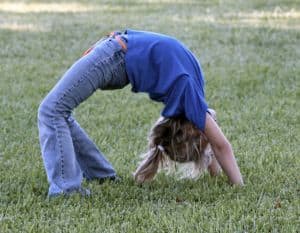It is no secret that children today lead more sedentary lives than their parents and grandparents did. Childhood obesity has more than doubled over the past three decades and screen time is at a record high between television, computers, tablets, video games, and smartphones. While it seems that the days of playing outside and simply “being a kid” are fading away, it’s not too late to turn the ship around. By introducing your kids to exercise routines and showing them how fun being active is, you can make a big difference.
What Is a Healthy Amount of Exercise For Kids?
The Centers for Disease Control recommends at least 1 hour per day of physical activity for children and adolescents. That time frame should include mainly aerobic activity, but muscle and bone strengthening exercise is also very important for growing bodies.
Sixty minutes per day is not difficult to achieve if you look for smaller time frames to incorporate activities, like walking to school or participating in organized sports a few days per week. The key is to pick age-appropriate activities that interest your kids so that they will look forward to the activity and form a positive opinion of healthy fitness pursuits.

Exercise by Age
Not all exercise is appropriate for all ages and some is more beneficial to certain age groups than others. Take a look at what should be the focus of an exercise routine for kids by age:
Infants/babies
Working with the smallest of kids to develop motor skills, like crawling, walking, and pulling up to a standing position is enough activity. This is also an important bonding time for parents and babies, so getting down on the floor and playing with infants is beneficial in physical and psychological ways.
Toddlers
A good 90 minutes of daily physical activity is not only helpful for a toddler’s health but benefits parents by providing a release for all of that extra energy. Toddlers learn most in play environments, so structuring just 30 minutes per day of planned physical activity is enough, as long as you provide active outlets for free, creative exploration on the part of the toddler.
Preschoolers
This group of kids requires the most amount of physical activity of all the age groups, at 2 hours. They still need an hour of unstructured, creative play but are physically able to handle another hour of planned activity too. Most preschools do have some built-in physical activity, but parents should still find ways to incorporate the difference at home.
School-age kids
As recess times at school decline, it is important that parents find at least 1 hour per day for their kids to exercise. Ideally this exercise should last at least 15 minutes at a time to have full effect. As children grow, they are also capable of doing some independent fitness activities that parents should encourage. Pay attention and listen to your children’s interests, and support whatever physical activity they love the most. Whether they want to play sports, take dance classes, or just jog around the neighborhood every day, as kids get older they need some independence when it comes to staying fit.
Every child will want to sit down and watch television from time to time or play a computer or tablet game. This is fine as long as it does not occur in excess. The CDC recommends that children under the age of 5 never remain inactive for more than an hour and that school age kids never remain inactive for more than 2 hours at a time—apart from nap and bedtime, of course.
The best way to get your kids excited about exercise is to set the example. Find family activities that you can all do together and cheer each other on at individual events, too.






Leave a Reply